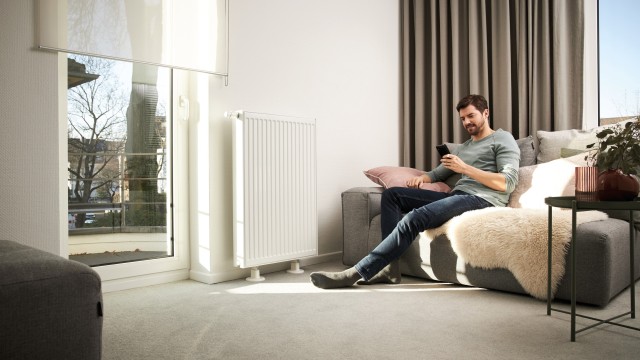To complete this step, you will need to first turn off your central heating and switch the required valves off either side of your radiator. The valves are typically located on the pipes to the left and right of the radiator and can be one of three types. Manual valves must be turned clockwise until they cannot turn further. Thermostatic valves need to be turned all the way to zero or off - not simply to a frost protection setting. Finally, lockshield valves need to have the plastic protective cap removed and turned clockwise using an adjustable wrench.
When adjusting the valves, note the number of turns made or the setting on the thermostatic valve to ensure flow rate and performance is retained.
Ensure you have a container placed beneath the manual control valve to catch any water that leaks out as your radiator drains. Use an adjustable wrench to loosen the nuts on the valve and allow for the radiator to drain. You may need to hold the valve in place with a second wrench should this prove difficult.
The bleed valve is found at the top of the radiator and will require a radiator key or screwdriver (system depending). Simply turn this until water begins to drain from the system. This can take time and older systems may have murky or dirty water, so be sure your container can hold all the water. To ensure all the water is drained, it can be wise to lift the radiator off it’s brackets and tilting it, though be sure to do so with care and with another person for added safety. To ensure utmost safety, we recommend hiring a certified boiler technician to avoid unintended injury or damage to persons or the heating system itself.
Once all the water has drained, fully remove the radiator from the brackets and place it aside. It’s highly unlikely that your new radiator will fit onto the existing brackets, so take this opportunity to remove the brackets from the wall.
Mark where your new brackets need to be installed to properly mount the radiator and check what’s behind this area with a digital detector - this will identify any pipes, cables or obstructions you need to be aware of before drilling into the wall. This step is one of the most accident-prone of all and to avoid any damage to your heating system, ensure you contact a professional to ensure this step is completed safely and effectively.
The exact process will depend on your brackets and radiator of choice, but this should be fairly straightforward. Simply drill the required holes and then screw the brackets onto the wall, mounting the radiator once you’ve confirmed the brackets are secure. Ensure to properly measure the bracket spacing and height on your wall, in order to ensure a proper mount for your radiator.
You will need to connect the pipes to the new radiator and ensure the connecting valve nuts are secure and tightly fastened, using PTE tape around each joint. Wrap PTE tape around each joint clockwise approximately 10 times. Return the valves to the original settings or turns, then slightly open the bleed valve to allow the radiator to fill with water. Once water bubbles at the bleed valve, your radiator is full and the bleed valve can be closed.
Ensure to check for any leakage from the system and keep cloth or towels on the floor until the installation is complete. At this point, your radiator should be functioning correctly and you’ve completely replaced your radiator!
Depending on the type of heating system you have, you might need to top up your boiler and heating system’s pressure after swapping your radiators to replace the water you drained from the old radiator. We’ve made a handy guide to help you do this, find out more by clicking here.
If you’re ever unsure during any of the above steps or want confirmation the replacement has been completed successfully, always consider speaking to a certified professional.



